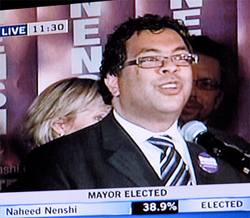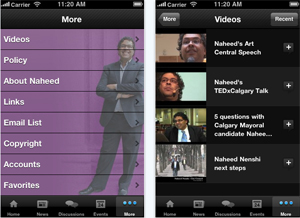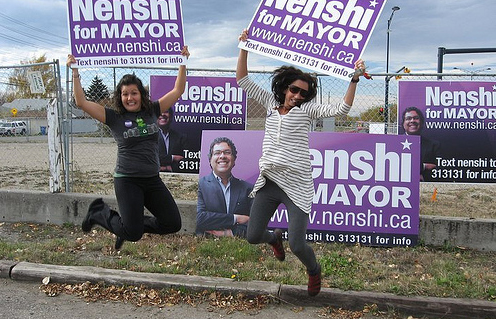Social Media content on MediaShift is sponsored by the John S. Knight Journalism Fellowships, a program offering innovative and entrepreneurial journalists the resources of Stanford University and Silicon Valley. Learn more here.
Naheed Nenshi became mayor of Calgary at the end of October not by outspending his rivals or hailing from the incumbent political class in Canada. Nenshi didn’t plaster his campaign message across the television, and he didn’t even buy a single newspaper advertisement.

Instead, Nenshi led a grassroots effort that mobilized soccer moms and utilized online activism on a Facebook page, on Twitter and on YouTube.
Other politicians have used Facebook and Twitter with success. So what was different about Nenshi’s campaign?
Stephen Carter, who helped craft the online campaign strategy for Nenshi, credited “complete integration” for the success of the campaign’s Internet efforts.
Integration
“It’s one thing to have a social media policy, but frankly just having social media activity doesn’t go far enough to actually making a campaign structure work,” Carter said. “It’s the integration of the online strategy, and we integrated our online strategy completely.”
Calgary had just received a fresh batch of snow when I spoke to Carter, who runs the BBold PR new media public relations company in the city. During our phone conversation I asked him to elaborate on his integration strategy and identify what made the Nenshi campaign so special.
“If we were going to do something online, we would partner that online participation with everything else so that it was all supported,” he said. “Our media relations strategy frankly became a social media strategy. If we wanted something to get really covered in the media, we launched it online. We wouldn’t even send out a press release.”
Carter said journalists now pay close attention to social media, which made a traditional press release a waste of time.

“Actually, social media became the story more often than not,” Carter said. “When we launched our iPhone app that became the story. It really wasn’t that innovative. In every election there’s this desire to look for the magic bullet. Was social media the magic bullet for us? Absolutely not.”
Authenticity
So if the Nenshi campaign shouldn’t be regarded as pioneers of social media, what was so special about what they did? Put it this way: They didn’t just use social media — they actually used social media correctly.
“When Nenshi and about six of us around the table were talking about social media, we talked about integrating the message into social media so that Nenshi would be always authentic,” Carter said. “The only person who had the password to Nenshi’s Twitter account was Nenshi. There was no second account set up for the campaign. Everybody was real. Every person that worked for the Nenshi campaign had their own Twitter account, which allowed us to have authentic communications across the medium.”
Nenshi campaign staffers also worked hard at starting online conversations. Whenever anyone from the campaign posted a message on Facebook, they set goals to see multiple comments underneath it. And as often as possible, Nenshi himself would answer questions posted on Facebook or Twitter.
All About the Data
Being authentic is one thing, but how do you know if your authenticity is being well received? Another major component to Carter’s strategy was to gather data and constantly measure and analyze the campaign’s online efforts.
“We trended on TrendsMap [which we used to perform] local tracking of our Twitter trends from the first day Nenshi announced he was running and basically every day thereafter to make sure we were tweeting and retweeting and pushing out our message every single day,” Carter said. “The beautiful thing about social media is that it is entirely measurable.
Being able to measure the impact of social media through retweets and shares on Facebook helped guide the campaign when things didn’t go according to plan — such as during a dust up with Rick Hanson, Calgary’s chief of police, over a pre-approved police budget.
Advertising Using Social Media
The final piece of the puzzle for Carter was advertising on Facebook. The campaign put out several different Facebook ads and regularly tested which ones worked.

“With our Facebook ads we decided we were going to try and appeal to middle aged women between 40 to 55, who live in the suburbs, have two kids and who have been or are soccer moms,” Carter said. “Everyone has this impression that social media is a young person’s medium. It’s totally not. We knew that we could get social media activism from that particular group. We targeted them on Facebook and put out a number of messages that appealed to their demographic.”
At the start of the Calgary election there was a total of 12 candidates. After raising about $60,000, Nenshi demonstrated he was a viable candidate. In August, Nenshi started at one percent support; he ended with 40 percent on election day.
Carter said the total amount raised during the campaign was about $300,000. Not bad considering how expensive large city elections have been for recent candidates.
“The biggest surprise was that the strategy was implemented exactly as planned,” Carter said. “It is ridiculous. That never happens. We certainly didn’t go into the campaign thinking that the strategy would work exactly as we wrote it, but it did.”
Steven Davy is the web content editor at The World, a BBC, WGBH, PRI co-production. He is also the developer of Exploring Conversations, a multimedia website examining the language of music. He is the politics correspondent for MediaShift.
Social Media content on MediaShift is sponsored by the John S. Knight Journalism Fellowships, a program offering innovative and entrepreneurial journalists the resources of Stanford University and Silicon Valley. Learn more here.

